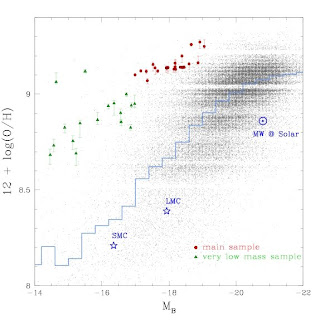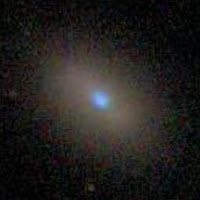Towards the last week of January, when I was hugely absorbed in trying to figure out a thesis proposal thing, a professor came into my office and started talking about the mass–metallicity relation. I knew about it, of course, but here was a new, simple idea: are the extreme outliers from this locus of galaxies real? In the spirit of a short "one month" project, it's now about three months later, and we've "finally" got a paper on said outliers on astro-ph. (I think this is a great example of: if anyone ever offers you a great idea, take it and run with it.)
So to back up a bit. What's this "mass–metallicity relation"? The short version is that a correlation exists between galaxy mass and metallicity such that the more massive a galaxy is, the more likely it is to be "metal rich." Originally this was the luminosity–metallicity relation, since how bright a galaxy is is much easier to measure than how massive it is, so on the right here I've plotted metallicity versus "absolute magnitude" in small grey points for a large sample of star-forming galaxies (remember: magnitudes are silly, so the right-hand side is brighter than the left-hand side, even though the numbers don't increase in that direction). Our outliers are, well, the larger red and green outliers from this relation; the different colors simply denote slightly different ways of selecting different subsamples. Astronomers being astronomers and not material scientists, when we say "metals" what we really mean is "any element which could not have been made in the Big Bang, i.e., basically anything not Hydrogen or Helium (or maybe Lithium but there's so little of that we'll completely ignore it)." There is of course a nice slew of caveats. The first is that the easiest way to measure the metallicity of galaxies is to limit ourselves to star-forming galaxies; all of those nice new young stars heat up the gas around them, and then as this gas cools it gives off emission lines. We can then look at the spectra of these galaxies and by measuring the how how strong various lines are relative to one another and combining it with some black magic (a.k.a. "spectral synthesis codes") we can measure the ratio of oxygen to hydrogen in a star-forming galaxy's gas. So I (and others!) basically use "metallicity" and "oxygen abundance" interchangeably, and, more precisely, I basically always mean "gas phase" abundance.
"mass–metallicity relation"? The short version is that a correlation exists between galaxy mass and metallicity such that the more massive a galaxy is, the more likely it is to be "metal rich." Originally this was the luminosity–metallicity relation, since how bright a galaxy is is much easier to measure than how massive it is, so on the right here I've plotted metallicity versus "absolute magnitude" in small grey points for a large sample of star-forming galaxies (remember: magnitudes are silly, so the right-hand side is brighter than the left-hand side, even though the numbers don't increase in that direction). Our outliers are, well, the larger red and green outliers from this relation; the different colors simply denote slightly different ways of selecting different subsamples. Astronomers being astronomers and not material scientists, when we say "metals" what we really mean is "any element which could not have been made in the Big Bang, i.e., basically anything not Hydrogen or Helium (or maybe Lithium but there's so little of that we'll completely ignore it)." There is of course a nice slew of caveats. The first is that the easiest way to measure the metallicity of galaxies is to limit ourselves to star-forming galaxies; all of those nice new young stars heat up the gas around them, and then as this gas cools it gives off emission lines. We can then look at the spectra of these galaxies and by measuring the how how strong various lines are relative to one another and combining it with some black magic (a.k.a. "spectral synthesis codes") we can measure the ratio of oxygen to hydrogen in a star-forming galaxy's gas. So I (and others!) basically use "metallicity" and "oxygen abundance" interchangeably, and, more precisely, I basically always mean "gas phase" abundance.
One of the interesting interchanges between theory and observation is that sometimes there will be some interesting observation (such as the obervation that galaxy mass and metallicity are correlated). So theorists will come up with a bunch of reasons why this is the case, and a few will even attempt to give explanations fo the scatter about the observed relation. A robust theory will also be able to explain seemingly strange galaxies: if a theory is able to explain why low mass galaxies have such low metallicities, then it should also be able to predict in what ways a low mass galaxy with high metallicity is different from its more mundane cousins. I spend a lot of the paper exploring various explanations (and then eliminating them) for why these galaxies could be so "weird," but I eventually hit upon one explanation which, in retrospect, is blindingly obvious.
The idea is that low mass galaxies have low metal abundances because they have low star formation rates and relatively high gas fractions (i.e., the fraction of their mass that is in gas rather than stars is large). An easy way to think of this is like so: stars turn hydrogen and helium into more massive elements (metals). As stars are formed, they the most massive ones die quickly, throwing their metal-rich selves back into the surrounding gas, thereby raising the metallicity of that gas. But a low star formation rate in a high gas fraction environment will not be making enough metals in order to fully pollute the gas around it, and so the fraction of metals in the gas will be relatively low. (This argument only really works for low-mass galaxies, but since those are the ones we're interested in, I'll ignore that subtlety for now.)
 So how do you get high-metallicity low-mass galaxies? Well, presumably the galaxy would need either a very high star formation rate (so the massive stars can actually pollute the gas) or a very low gas fraction (so each supernova has a higher impact on the gas). We find that these outliers don't have unusually high star formation rates, so we conclude that they must have rather low gas fractions. But this is the same gas the stars are forming out of! So the star formation must not have very long left to go. A nice bit of supporting evidence for this scenario is the occasional mention in the literature that so-called "transition" dwarf galaxies tend to have low gas masses and higher-than-expected gas-phase metallicities; these galaxies are known as "transition" objects because they are between regular star-forming dwarfs and quiescent non-starforming dwarf galaxies. The especially neat part is that several of these galaxies have the star formation limited to their centers (like this galaxy to the left: blue in a galaxy is a sign of lots of young, recently formed stars). One way to interpret this is that star formation used to occur on all scales in this galaxy, but the gas has since been extinguished (or blown out of the galaxy) at the larger scales.
So how do you get high-metallicity low-mass galaxies? Well, presumably the galaxy would need either a very high star formation rate (so the massive stars can actually pollute the gas) or a very low gas fraction (so each supernova has a higher impact on the gas). We find that these outliers don't have unusually high star formation rates, so we conclude that they must have rather low gas fractions. But this is the same gas the stars are forming out of! So the star formation must not have very long left to go. A nice bit of supporting evidence for this scenario is the occasional mention in the literature that so-called "transition" dwarf galaxies tend to have low gas masses and higher-than-expected gas-phase metallicities; these galaxies are known as "transition" objects because they are between regular star-forming dwarfs and quiescent non-starforming dwarf galaxies. The especially neat part is that several of these galaxies have the star formation limited to their centers (like this galaxy to the left: blue in a galaxy is a sign of lots of young, recently formed stars). One way to interpret this is that star formation used to occur on all scales in this galaxy, but the gas has since been extinguished (or blown out of the galaxy) at the larger scales.




